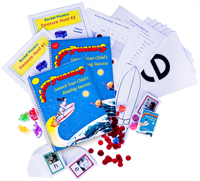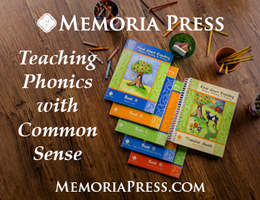Rocket Phonics is quite different from other phonics programs. It teaches systematic phonics using games, activities, and a system of prompting “symbols.” The prompt system functions somewhat like the artificial alphabet used in Teach a Child to Read in 100 Easy Lessons. The benefit to this approach is that children are able to learn to read sentences in the course books more quickly than in other programs since children have to master fewer phonograms at the beginning—there are only 36 phonograms taught in the first part of Rocket Phonics. These phonograms are called the “initial teaching alphabet” (ITA). The downside is that the transition to reading without the prompting symbols is an extra step, and learning to spell correctly rather than phonetically might be more challenging for students.
Rocket Phonics is taught from two large, spiral-bound books. These come boxed with two sets of Play & Read phonogram picture cards (and the instructions for games and learning activities using the cards). There's also a folder with pages to be used for bingo games, evaluation sheets, and a rocket “peeker” (a rocket card with a small square cut out so that children can isolate phonograms and words they are trying to read). Two Treasure Hunts offer extra fun for reading practice. (Additional optional print resources are sent via email to those purchasing the program.)
The program begins with phonemic awareness using oral/auditory games and the Play & Read Cards for both games and instruction. Those teaching preschoolers or Wiggly Willys might want to use ideas from the Preschool/Big Movement Games suggestions that come in the email packet.
The Play & Read Cards and bingo games help children learn to associate the sounds with the phonograms. (The phonograms are called symbols in Rocket Phonics). When children have learned the first group of nine symbols, they learn to blend the sounds. They work with two-letter blends, both vowel-consonant and consonant-vowel as well as nonsense blends like “ke, ik,” and “ef.” Fairly soon, children should be ready to move on to three-letter words that use only the first nine phonograms.
The program continues to introduce the rest of the 36 phonograms in the ITA, nine at a time. Rather than explaining long vowel sounds at this point, the program teaches them among the 36 phonograms as /ay/, /ea/, /ie/, /oa/, and /oo/ (as in food). Long vowels are taught more explicitly later in the program (p. 113).
In addition to playing bingo and using the Play & Read Cards, parents teach with activities such as matching activities in the book, matching activities with pictures placed around the house, a “baseball” identification game where children move around four “bases,” and charade games.
Children practice reading the phonograms and words from the book—what they are to read is printed in blue to be clearly identifiable. Once children are ready to start reading words that use phonograms or pronunciations other than those already learned, the program introduces the prompt system. The prompt system presents the words to be read on one line with prompts in a smaller size font immediately beneath. The words on the top line have letters to be pronounced phonetically in blue and other letters in gray. Prompts directly beneath the gray letters “substitute” the 36 phonograms to show the actual pronunciation. Thus, students have to scan both the top line and the prompts below to decode the words. For example, the word “great” has the letters g, r, and t in blue. The ea is gray. Beneath the ea is the phonogram ay which tells the child to substitute the long a sound.
The rest of the lessons present reading material in this fashion. However, in the second book the reading material is presented both with and without prompts. Children are to read the prompted version first then the unprompted version. This helps them make the transition to normal reading.
Fairly early in the program, children learn how to detect syllables within words and learn to ready multi-syllable words. Phonograms other than those in the ITA start to be taught in lessons toward the end of the first book. By the end of the first book, children are reading simple versions of “The Fox and the Grapes” and other Aesop's fables. Oral comprehension questions are introduced toward the end of the first book. (Some questions are critical-thinking questions rather than comprehension questions.)
The second book adds more fables, non-fiction selections, and the story of Cinderella.
Instruction on other phonograms and word patterns, prefixes and suffixes, syllables, and spelling patterns is included in each section so that children quickly learn to read the controlled vocabulary then gradually add to it as they learn additional phonograms, word structures, and decoding strategies.
The final section of lessons, titled “Beyond Rocket Phonics,” “is designed to further your child's skills for reading independently at fifth/sixth grade level and above.” This section teaches about accented syllables, unusual suffixes, and the pronunciation of Spanish and Latin vowels. Reading material is more advanced although it is still presented in both prompted and unprompted versions. Older students who have not mastered phonics might find Rocket Phonics a good choice since it covers a wide range of skill levels. Older students might be able to move very quickly through or skip the phonemic awareness and blending steps, essentially starting further along in the program.
On the other hand, the program can be used with students as young as Pre-K as long as you don't push them through it too quickly. (Younger preschoolers will enjoy and learn from many of the activities and games at the beginning of the book too.) The program normally should take 1 1/2 to 2 years to complete. Even if students do not complete the “Beyond Rocket Phonics” section, they will likely be reading at fourth or fifth grade level. Of course you have to work on vocabulary and comprehension with younger children to actually have them read with understanding at those levels.
Rocket Phonics is designed to make learning to read a fun experience. Reading material often includes rhymes, jokes, riddles, and silly sentences. Many of the games as well as optional activities can be used to address the individual learning style needs of students—the program requires only minimal effort and probably no expense for most games and activities. The books and cards have full-color illustrations. Sometimes illustrations help children to check whether or not what they are reading is making sense, but children cannot easily predict what they are to read from the illustrations. Children will certainly enjoy the Treasure Hunts with clues that you will hide around the house. Children read each clue which directs them to the next in the series of clues until they find the treasure—treasures (small balls and gel worms) are included in the kit.
To begin, parents need to first read through the introductory material and determine where to start and which activities to use. The Quick Start page might shorten the process for you. Once you've started, less advance planning is required. However, this is a very interactive, teacher intensive program. Lessons are often scripted with what the parent needs to say. However, there is no distinction in fonts between scripted lines and explanation for the parent, so it's a good idea to read ahead so you know how to use each lesson.
Rocket Phonics is unusual, but I suspect it will be especially effective for children who enjoy active learning and games. It certainly makes the process of teaching reading more fun for parents.











